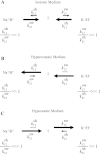Coordinated control of volume regulatory Na+/H+ and K+/H+ exchange pathways in Amphiuma red blood cells
- PMID: 19940069
- PMCID: PMC2838575
- DOI: 10.1152/ajpcell.00141.2009
Coordinated control of volume regulatory Na+/H+ and K+/H+ exchange pathways in Amphiuma red blood cells
Abstract
The Na(+)/H(+) and K(+)/H(+) exchange pathways of Amphiuma tridactylum red blood cells (RBCs) are quiescent at normal resting cell volume yet are selectively activated in response to cell shrinkage and swelling, respectively. These alkali metal/H(+) exchangers are activated by net kinase activity and deactivated by net phosphatase activity. We employed relaxation kinetic analyses to gain insight into the basis for coordinated control of these volume regulatory ion flux pathways. This approach enabled us to develop a model explaining how phosphorylation/dephosphorylation-dependent events control and coordinate the activity of the Na(+)/H(+) and K(+)/H(+) exchangers around the cell volume set point. We found that the transition between initial and final steady state for both activation and deactivation of the volume-induced Na(+)/H(+) and K(+)/H(+) exchange pathways in Amphiuma RBCs proceed as a single exponential function of time. The rate of Na(+)/H(+) exchange activation increases with cell shrinkage, whereas the rate of Na(+)/H(+) exchange deactivation increases as preshrunken cells are progressively swollen. Similarly, the rate of K(+)/H(+) exchange activation increases with cell swelling, whereas the rate of K(+)/H(+) exchange deactivation increases as preswollen cells are progressively shrunken. We propose a model in which the activities of the controlling kinases and phosphatases are volume sensitive and reciprocally regulated. Briefly, the activity of each kinase-phosphatase pair is reciprocally related, as a function of volume, and the volume sensitivities of kinases and phosphatases controlling K(+)/H(+) exchange are reciprocally related to those controlling Na(+)/H(+) exchange.
Figures







Similar articles
-
Activation of Na+/H+ and K+/H+ exchange by calyculin A in Amphiuma tridactylum red blood cells: implications for the control of volume-induced ion flux activity.Am J Physiol Cell Physiol. 2008 Nov;295(5):C1316-25. doi: 10.1152/ajpcell.00160.2008. Epub 2008 Sep 17. Am J Physiol Cell Physiol. 2008. PMID: 18799654 Free PMC article.
-
Volume regulation by Amphiuma red blood cells: cytosolic free Ca and alkali metal-H exchange.Am J Physiol. 1986 Mar;250(3 Pt 1):C423-9. doi: 10.1152/ajpcell.1986.250.3.C423. Am J Physiol. 1986. PMID: 2420196
-
pH regulatory Na/H exchange by Amphiuma red blood cells.J Gen Physiol. 1994 Jun;103(6):1035-53. doi: 10.1085/jgp.103.6.1035. J Gen Physiol. 1994. PMID: 7931136 Free PMC article.
-
Cell volume and pH regulation by the Amphiuma red blood cell: a model for hypoxia-induced cell injury.Comp Biochem Physiol Comp Physiol. 1992 Aug;102(4):603-8. doi: 10.1016/0300-9629(92)90711-x. Comp Biochem Physiol Comp Physiol. 1992. PMID: 1355022 Review.
-
Regulation of Na+/H+ antiporter in trout red blood cells.J Exp Biol. 1997 Jan;200(Pt 2):353-60. doi: 10.1242/jeb.200.2.353. J Exp Biol. 1997. PMID: 9050244 Review.
Cited by
-
Phosphorylation and activation of the plasma membrane Na+/H+ exchanger (NHE1) during osmotic cell shrinkage.PLoS One. 2011;6(12):e29210. doi: 10.1371/journal.pone.0029210. Epub 2011 Dec 28. PLoS One. 2011. PMID: 22216214 Free PMC article.
References
-
- Bize I, Dunham PB. Staurosporine, a protein kinase inhibitor, activates K-Cl cotransport in LK sheep erythrocytes. Am J Physiol Cell Physiol 266: C759–C770, 1994 - PubMed
-
- Cala PM. Volume regulation by red blood cells: mechanisms of ion transport. J Mol Physiol 4: 33–52, 1983
Publication types
MeSH terms
Substances
Grants and funding
LinkOut - more resources
Full Text Sources
Medical

